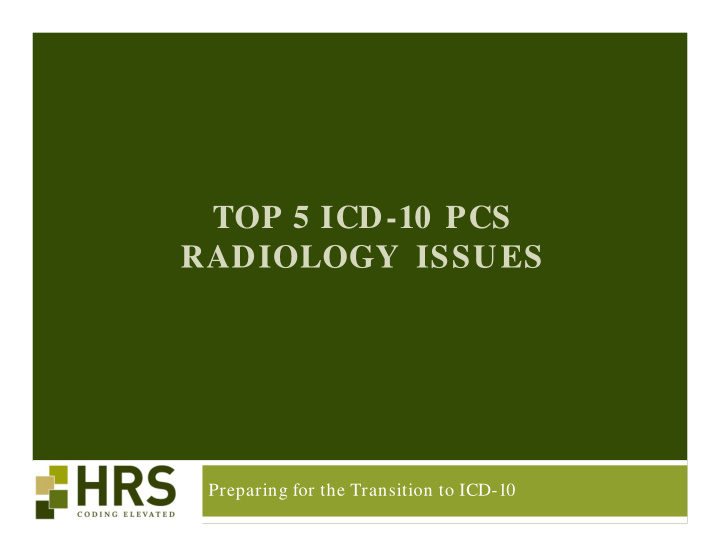



TOP 5 ICD-10 PCS RADIOLOGY ISSUES Preparing for the Transition to ICD-10
New Coding Elem ents ICD-10 PCS coding will require several additional elements 1) Modality (CT, MRI, US, NM, RAD) 2) High or Low Contrast is a required element of ICD-10 PCS coding. 3) Combined Unenhanced/ Enhanced CTs and MRIs have specific ICD-10 codes. 4) Laterality is a required element of ICD-10 PCS coding. 5) Implants are a required element of ICD-10 PCS coding when used.
Modality Most radiology services are found in two of the Ancillary sections; Imaging, Section “B” and Nuclear Medicine, Section “C”. In order to find the appropriate ICD-10 PCS code, the modality must be known. For Example, CT of the abdomen, the main term Computerized Tomography (CT Scan) would be referenced in the index, with the sub terms abdomen. After consulting the BW20 table, the complete code would be BW20ZZZ.
Contrast Contrast will be a required component of ICD-10 PCS coding. The documentation must identify the type of contrast (High, Low, Other for MRI and the radionuclide for nuclear medicine). The fifth character of ICD-10 PCS identifies the type of contrast when used. Example, Imaging Cervical Spine with Low Osmolar Contrast BR20 1 ZZ. The fifth digit “1” in this code represents low osmolar contrast
Com bined Unenhanced/ Enhanced Some CT and MRI procedures can be performed with and without contrast. These services require additional time and recourses. These services were assigned separate codes to distinguish them from procedures with or without contrast. Example, Imaging abdomen CT Unenhanced and Enhanced with high osmolar contrast BW200 0 Z. The sixth digit “0” represents Unenhanced and Enhanced .
Laterality Laterality is a required element of ICD-10 PCS coding. All extremity, most vascular, many organs and many other imaging procedures will require left or right Example, MRI of Right Hip without contrast BQ3 0 ZZZ. The fourth digit “0” indicates right hip.
Im plants Implants are a required element of ICD-10 PCS coding when used. Procedures requiring implants can be found in the Medical Surgical section. Services such as pacemaker, breast implants and vascular stents will require the type of implant. Example, Percutaneous Placement of Central Line in Rt Internal Jugular 05HM3 3 Z. The sixth digit “3” represents the infusion device (Central Line).
The Need for Additional Info Ordering physicians will need to add detail to their request for imaging services. Radiologists rely on the ordering physician for: the exam reason wording of a completed exams will need to be more specific and more detail pertinent information related to an ordered exam
Scheduling Scheduling departments, Registration, and particularly Imaging facilities will need to acquire a much greater history for a patient when scheduling an exam for the purposes of precertification
Docum entation Challenges Radiologists must be much more specific and detailed in their documentation and wording. The degree of specificity needed for coding could depend on inpatient or outpatient. Radiologists will need to pinpoint the areas being imaged and the type of imaging being performed.
Questions CO CONTAC ACT H HRS 800-329-0365 800-329-0365 www www.HRSc HRScoding.c oding.com om
Recommend
More recommend